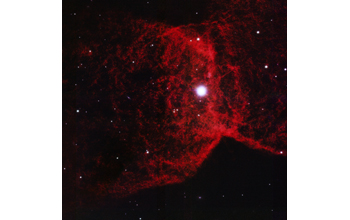Multimedia Gallery
Planetary nebula NGC 2346
A single-pointing, near-infrared image of the planetary nebula NGC 2346, obtained with the Gemini South Telescope's Gemini Multi-conjugate Adaptive Optics System (GeMS)/Gemini South Adaptive Optics Imager (GSAOI).
Planetary nebulae are the gaseous remnants of low- and intermediate-mass stars. Evolved planetary nebulae, such as NGC 2346, contain a variety of complex and poorly understood filamentary and clumpy structures. Principal investigator Letizia Stanghellini of the National Optical Astronomy Observatory and colleagues utilized the high-resolution capability of GeMS to detect these features at scales that would reveal the physical processes leading to their formation. "From the observation point of view," Stanghellini says, "such an analysis is possible only with the resolution afforded by GeMS/GSAOI. The data will enable us to explore the nature and evolution of planetary nebulae microstructure, and to study the molecular formation and destruction processes in great detail. This will greatly advance our understanding of chemical recycling in our galaxy and other stellar systems."
[Technical Data: This image, made from H2(2-1), Brackett gamma and H2(1-0) filters, was assigned the colors blue, green and red, respectively. The field of view is 1.4 x 1.4 arcminutes and is oriented with north to the left. The total (integrated) exposure time was 70 minutes cumulative for all filters. Image data from Letizia Stanghellini, National Optical Astronomy Observatory, Tucson, Ariz. Color composite image by Travis Rector, University of Alaska Anchorage.]
To learn more about the Gemini Observatory, visit the facility's website Here. (Date of Image: unknown)
Credit: Gemini Observatory/AURA
Images and other media in the National Science Foundation Multimedia Gallery are available for use in print and electronic material by NSF employees, members of the media, university staff, teachers and the general public. All media in the gallery are intended for personal, educational and nonprofit/non-commercial use only.
Images credited to the National Science Foundation, a federal agency, are in the public domain. The images were created by employees of the United States Government as part of their official duties or prepared by contractors as "works for hire" for NSF. You may freely use NSF-credited images and, at your discretion, credit NSF with a "Courtesy: National Science Foundation" notation.
Additional information about general usage can be found in Conditions.
Also Available:
Download the high-resolution TIF version of the image. (52.6 MB)
Use your mouse to right-click (Mac users may need to Ctrl-click) the link above and choose the option that will save the file or target to your computer.



